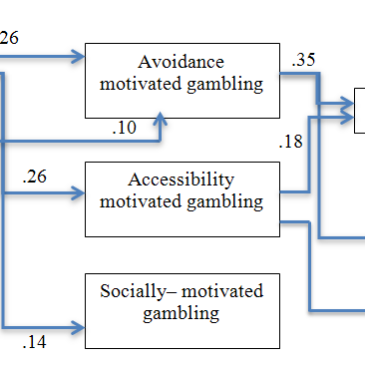Research suggests that some people
might develop addictive behavior through their attempts to escape or avoid
experiences associated with stressful life events (Blaszczynski & Nower, 2002; Cooper, Frone, Russell, & Mudar, 1995).
Other contributing factors to developing addictive behavior include proximity
to and accessibility of potential objects of addiction (Cox, Yu, Afifi, & Ladouceur, 2005; Shaffer et al., 2004). This
week’s WAGER reviews a study that examined how these factors intersect and relate to gambling motivation,
frequency and gambling-related problems (Thomas,
Allen, Phillips, & Karantzas, 2011).
Methods
- Three hundred forty seven (229 females) current
gamblers who use electronic gambling machines (EGM) recruited through flyers in
various public message boards participated in the study. - Participants completed a survey regarding their
demographic information and frequency of EGM gambling. - Participants also reported whether they experienced stress
(defined as a major life change or loss) since commencing EGM and whether they
ever escaped from their problems by using behavior such as drinking alcohol, using
drugs or eating (0: never to 4: a lot of time) (i.e., general avoidance
coping). - Next, participants completed the following measures:
- The EGM motivation scale (Thomas, Allen,
& Phillips, 2009) , which consists of three subscales assessing avoidance
(e.g., Gambling provides a break from
worrying), accessibility (e.g., Venues
are close) and social (e.g., I can
meet new people) motivation. Response options ranged from 0 (Doesn't apply to me) to 5 (Applies to me almost always). - Problem gambling severity index (Ferris
& Wynne, 2001) – e.g., Have
you bet more than you could really afford to lose? Response options ranged
from 0 (Never) to 3 (Almost always).
- The EGM motivation scale (Thomas, Allen,
Results
- Figure 1 depicts
significant (p < .05)
correlations among measured variables. Specifically,- Self-reported stress
correlated with all three types of gambling motivation. - Self-reported stress
related to general avoidance coping, which in turn related to
avoidance-motivated gambling. - Those who reported
stronger avoidance and accessibility motives for gambling reported having
more gambling-related problems and playing electronic gambling machines
more frequently.
- Self-reported stress
Figure 1: The
relationships among stress, avoidance coping, gambling motivations, frequency
and problems.
Limitations
- This is a correlational study; therefore, we cannot conclude if avoidance
motivation leads to gambling frequency and problems or vice versa, or if a
third variable is related to both factors. - Measures have the usual limitations of self-report
and therefore may not accurately reflect individual’s situational stressors,
motivations, and actual gambling behavior.
Conclusion
The results revealed that experiencing a stressful life
event was positively related to avoidance, accessibility, and social motives
for gambling. However, only avoidance and accessibility motives for gambling
were related to frequency of gambling and gambling-related problems; social
motivation did not relate to gambling related problems. This implies that to
predict how stressful life events relate to potential future gambling-related
problems, it is important to understand typical gambling motivations. The
results also demonstrated that the tendency to escape from problems using drugs
and alcohol is related to avoidance-motivated gambling, which is in turn
related to gambling frequency and problems. This supports the view of problem gambling
as a phenomenon that shares common antecedents with other expressions of addiction
(Shaffer, et al., 2004). Future research designs
that include experimental manipulations (e.g., of stress or gambling
motivation) might shed light on causal mechanisms.
-Julia Braverman
What do you think? Please use the comment link below to provide
feedback on this article.
References
Blaszczynski, A., & Nower, L. (2002). A pathways
model of problem and pathological gambling. Addiction,
97(5), 487-499.
Cooper, M. L., Frone, M. R., Russell, M., & Mudar,
P. (1995). Drinking to regulate positive and negative emotions: A motivational
model of alcohol use. Journal of
Personality and Social Psychology, 69(5), 990-1005.
Cox, B. J., Yu, N., Afifi, T. O., & Ladouceur, R.
(2005). A National Survey of Gambling Problems in Canada. The Canadian Journal of Psychiatry / La Revue canadienne de
psychiatrie, 50(4), 213-217.
Ferris, J., & Wynne, H. J. (2001). The Canadian Problem Gambling Index: Final
report.
Shaffer, H. J., LaPlante, D. A., LaBrie, R. A.,
Kidman, R. C., Donato, A. N., & Stanton, M. V. (2004). Toward a syndrome
model of addiction: Multiple expressions, common etiology. Harvard Review of Psychiatry, 12, 367-374.
Thomas, A. C., Allen, F. C., & Phillips, J.
(2009). Electronic gaming machine gambling: Measuring motivation. Journal of Gambling Studies, 25(3),
343-355.
Thomas, A. C., Allen, F. L., Phillips, J., &
Karantzas, G. (2011). Gaming machine addiction: The role of avoidance,
accessibility and social support. Psychology
of Addictive Behaviors, 25(4), 738-744.






Terry McCarthy February 6, 2013
My small band of compulsive gamblers each reveal that their gambling was different from others from a very young age. One man claims that his compulsion started at age 8, with a raffle at an ice cream social. It got out of the control later and most eventualy were escaping something, but the difference between themselves and others was noted at a very young age. They each started recreationally and escalated later, and only began using gambling as an escape after the compulsion arose.